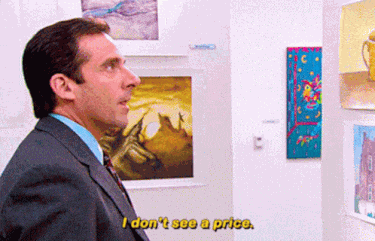Art can do more than brighten a living space. The art market has become one of the hottest new investment crazes in recent years. Painting and sculpture collectors frequently buy pieces with an eye towards adding to their investment portfolio.
But will art investment really earn you a profit? Or is this new asset class mostly hype?
Is fine art a good investment?
This question really depends on your personal investment goals.
Like stocks and bonds, art can increase in value. If an up-and-coming artist goes on to a successful career, the cash value of their work will skyrocket. An Art Basel annual report estimates global art market sales reached over $67 billion in 2022.
But before you dive into art investing, you should consider three factors:
1. Art Is a long-term investment
Profits from fine art won’t happen overnight. Experts recommend art investment for patient investors with a time window of 10 years or more, so think long term.
Many art investors include paintings in their estate planning as assets to pass on to their descendants.
2. The art market follows rules of its own
One major perk of art as an asset is that its value doesn’t rise or decline with the stock market. Even if your stocks aren’t performing well, your art investment may be doing great — good news for the savvy investor who wants to diversify their investment portfolio and potentially minimize risk.
And ideally, though not always, art will continue appreciating in value over time.
3. Art is risky
Every artwork is unique, and the fine art market has ups and downs just like any other market.
Since it’s impossible to determine an artwork’s true value — a lot depends on the artist’s reputation and on the economy as a whole — you should be comfortable assuming some risk when investing, especially in art.
How to invest in art
Start by deciding how much money you’re prepared to spend. It should be an amount you can afford to part with in case the artwork depreciates. Don’t forget to factor in possible storage and maintenance costs.
Next, decide whether you want to buy individual pieces of art or invest in an art fund. An art fund works somewhat like a mutual fund except, instead of investing in stocks, the art fund invests in pieces of artwork.
Masterworks is the leading art fund right now with over 800,000 members invested.
Investing in your own pieces is a lot riskier, but potentially more rewarding — both in terms of eventual returns and because you’ll be able to enjoy your artwork in the meantime. Learn as much about the art world as you can. Visit local galleries and see what they have to offer; chat with curators, who will usually be eager to answer any of your questions.
If you live in or near a city, you’re probably close to gallery openings and art fairs, where up-and-coming artists tend to showcase their pieces.
Browse sites like Artnet and online auction houses like Sotheby’s to get a sense of how the art market works.
Once a piece or artist catches your eye, you can start narrowing down your research to see how much a particular artwork costs. You can get the artwork appraised by a professional appraiser to determine its quality.
You can either purchase an artwork yourself — often the costlier option — or buy shares in artwork through an online marketplace.
Online Art Marketplaces
Since this is the information age, plenty of high-end artwork sells online. But before you buy over the Internet, make sure you’re purchasing from a legitimate gallery, dealer, or investment firm.
As we mentioned, Masterworks is a great online option, especially for the novice art investor because they do most of the work for you. Masterworks buys paintings and sell shares to investors, keeping you updated on the investment as it progresses.
With Masterworks you don’t actually own or store the artwork. Instead, you and several other investors purchase shares in high-value works vetted by experts for authenticity. Masterworks does not have specific minimum investment amounts; minimums vary depending on the specific investment offerings available at the time you’re investing.
A somewhat similar marketplace to Masterworks is Saatchi Art, where you can browse and purchase directly online.
What to know before investing in art
Here’s a few things you should consider before you diversify your portfolio with artwork.
It should only be a small part of your portfolio

For most people art will be only a small fraction of a well-rounded investment portfolio. You may profit, but you’re highly unlikely to get a huge payout from art alone.
Think of it like a real estate investment: extra, not essential. Don’t rely on an art investments for steady income. And don’t forget you’ll be paying taxes on any gains, since the IRS considers art a collectible.
Art is non-liquid
It’s important to remember that fine art is a non-liquid or illiquid asset. This means it’s difficult to convert into cash right away and should be considered when you’re mastering your asset allocation.
Liquid assets, like stocks, bonds, and savings accounts, can produce cash more easily. Illiquid assets, like real estate and art, take much longer to sell even if they have great monetary value.
Though it’s possible to sell your art, most investors don’t. An auction house, your best bet for selling, often charges hefty fees. Since art prices fluctuate regularly there are no guarantees selling will earn you a profit.
When should you invest in art?
Here are some signs the reward and experience might outweigh the risk.
You love art
Most art investors start out as art collectors. If you love going to galleries and you’re already on the lookout for a great piece to add to your home, turn that appreciation into an asset! But if you don’t like art for its own sake, other options with an investment account will serve you better.
You don’t have to be a collector to start investing in art. You can keep your investments to just one or two pieces. But knowledge of the art world — or working with someone who has this knowledge — is key if you want to pick winners.
You’re not counting on earnings

The best approach to art investment? Consider the aesthetic pleasure first and the financial benefits second.
Welcome any profits, but don’t plan your financial future around receiving those profits. Any money earmarked for retirement, for instance, should go into other assets. In fact, one Stanford Business study says art is unlikely to improve any portfolio.
Bottom line: don’t invest anything in art you can’t afford to lose.
You’re willing to research
That said, art investors can pick pieces with great long-term value. But enter informed, just as you would be if you invested in the stock market.
Start by researching the artist of the work you’re considering. Ask the following questions:
- Are their pieces included in any museums or famous collections?
- Have they won awards or gained other recognition for their work?
While up-and-coming artists can be exciting, their reputations may or may not last. And this will affect the value of their piece.
You can afford the maintenance
Art investors get to control their assets, which can be a bonus. But you’re responsible for keeping the artwork in pristine condition, which means monitoring factors like humidity and sunlight.
If you display the artwork you’ll have to make sure it maintains its original quality. If you put it in storage you’ll pay for that as well. Add insurance costs and the price of an authenticity certificate, and your maintenance bill adds up.
As you can see, art investing is a little more complicated than buying index funds.
What to look for when buying art
The art world is broad, so to narrow down your search, pick a genre or time period that interests you. Then find an expert to help you look.
We recommend working with an art advisor or an investment company specializing in art (we’ve listed some options below.)
Having someone in your corner helps when it comes time to determine the fair market value of an art piece, making sure you get your money’s worth.
Once you’ve found your area of focus, know what kind of piece you’re buying.
- Originals or one-of-a-kind works of art come with the highest price but the greatest potential payoff.
- Prints or copies are more affordable but less likely to turn a profit. The best quality print is known as a giclée (zhee-klay). It’s similar to the original work than other prints, but also more expensive. As a rule, rarer prints are more valuable. One print from a small number of limited editions will have more value than a print with many copies floating around.
- Reproductions are mass-produced copies without a limited run. They’re the most affordable option, but they’re also worth the least. You probably won’t see any profit from a reproduction.
No matter what, look for quality and good condition. Especially for pricey investments, it’s worth spending the extra cash to get an appraisal.
Where to look for art
Museums and art galleries, of course, are great places to go to invest in art. Art galleries typically specialize in selling artworks by established and emerging artists. They often have a curated selection of artist’s work on display for purchase.
Online art marketplaces such as Saatchi Art, Artsy, and Artfinder allow you to browse and buy art online from a wide selection of artists and galleries. You can diversify your portfolio and buy shares of art online with the experts at Masterworks.
Auction houses such as Christie’s and Sotheby’s sell high-end art pieces and you can bid on art in a more intense environment, but you can score a masterpiece if you’re lucky. Be aware auction prices often have a buyer’s premium in addition to the sticker price.
Art fairs are events where galleries and artists from around the world showcase their artworks for sale. You can also attend a local art fair where you could purchase artwork from a local artist to get your toes wet.
Also, keep in mind many artists sell their artworks directly to collectors through their own websites or social media platforms.
It’s important to do your research and buy from reputable sources to ensure that you are purchasing authentic art.
The bottom line: Should you invest in art?
If you want guaranteed returns on the money you invest, or if you don’t have much money to work with, you’re probably safer skipping the fine art gallery and sticking to liquid assets. Brand-new investors should also give their portfolio plenty of time to mature before taking the leap.
But for seasoned, confident investors who are enthusiastic about art — and who have extra funds to cover the costs — an investment in a painting or detailed sculpture can be an exciting way to diversify a portfolio.


